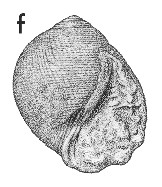
Revised descriptions of New Zealand Cenozoic Mollusca from Beu and Maxwell (1990)

 | Revised descriptions of New Zealand Cenozoic Mollusca from Beu and Maxwell (1990) | 
|
  (Pl. 2f): holotype, Wangaloa, Wangaloan (Otago University Geology Department) |
Beu & Maxwell (1990): Chapter 5; p. 82; pl. 2f.
Synonymy: Ampullina spiralis Marshall 1917, p. 452
Classification: Naticidae: Globisininae
Description: Size moderate for family (height 22-45 mm), ovate, spire relatively high for genus. Protoconch not distinguishable from teleoconch in available material; last whorl capacious, with a very narrow umbilicus. Sculpture of spiral grooves and low, narrow, flat-topped cords. Inner lip slightly sinuous, parietal callus very thin; outer lip only moderately prosocline (c. 20° to vertical).
Comparison: Globisinum spirale is distinguished from younger members of the genus by its relatively elevated spire, by its relatively prominent spiral sculpture and by its very narrow umbilicus. G. miocaenicum (Waitakian-Altonian) is lower-spired and more finely sculptured and has a better-defined umbilicus, G. crassiliratum (Pl. 15h) is much smaller, has distinctly impressed sutures and is more widely umbilicate, and G. drewi (Pl. 47t) is larger, lower-spired, more weakly sculptured and is not umbilicate. "G". elegans (Bortonian-Kaiatan) differs markedly from all the above in having very weak spiral sculpture (obsolete in some shells) and a wide umbilicus, and was transferred to Euspira (as the synonym Lunatia) by Maxwell (1992, p. 105). Species of Globisinum are readily distinguished from other New Zealand naticids by having a globose or ovate shell and relatively distinct spiral sculpture, and in being narrowly umbilicate or non-umbilicate. Spiral sculpture is also present in species of Sinum, Eunaticina and Propesinum, as well as Polinices propeovatus (Pl. 29l) and a few other New Zealand naticids, but these differ markedly from species of Globisinum in shell form and in umbilical and sutural characters. The unusual radula of G. drewi (Powell 1933a, fig. 19) is additional evidence for the distinctiveness of the genus and is the basis of Powell's proposal that it be placed in a separate subfamily. Dell (1956a, p. 46; 1990, pp. 153-155) suggested that Globisinum is closely related to Bulbus Brown, 1839 (= Acrybia H. and A. Adams, 1853) from the Arctic, Antarctic and North Atlantic.
Globisinum drewi ranges from mid-shelf to upper slope, and most of the fossil species seem to have occurred at similar depths, but G. spirale may have penetrated into shallower waters, to judge by its occurrence at Wangaloa.
Distribution: Wangaloan, Wangaloa Formation, Wangaloa (type); Boulder Hill (uncommon at both localities).
Cite this publication as: "A.G. Beu and J.I. Raine (2009). Revised
descriptions of New Zealand Cenozoic Mollusca from Beu and Maxwell (1990). GNS
Science miscellaneous series no. 27."
© GNS Science, 2009
ISBN
978-0-478-19705-1
ISSN 1177-2441
(Included with a PDF facsimile file
copy of New Zealand Geological Survey Paleontological Bulletin 58 in CD version
from: Publications Officer, GNS Science, P.O. Box 30368 Lower Hutt, New
Zealand)